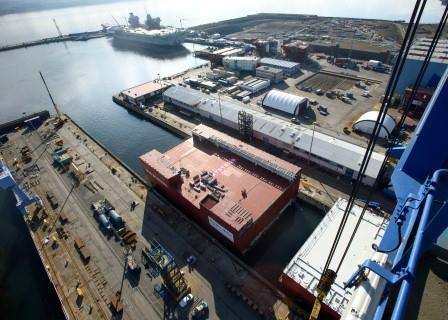Peter Roberts analyzes the design trade-offs of the Queen Elizabeth class for the Royal United Services Institute:
The most important change in the Queen Elizabeth class is the open acknowledgement of the primacy of running costs at the heart of the project – manifest in crew numbers, unmanned monitoring and power generation. The UK carriers are platforms designed by economists, not warriors.
The largest costs for running maritime platforms are manpower and fuel. In terms of manpower, the Queen Elizabeth will have a crew of 650 with an additional thousand berths available for the air group. By comparison, the American Nimitz class and new Gerald Ford class, which displace around 40,000 tonnes more, are crewed by 6,000 and 4,500 personnel respectively. The French Charles de Gaulle, which in terms of tonnage is about a third smaller its British counterpart, carries a crew of around 2,500. The UK figures were driven by the necessity to avoid increasing the manpower bill of the Royal Navy. As such, the 650 figure is exactly the same as the preceding Invincible class. Allowing the same complement to effectively operate a vessel three times the size of her predecessor has forced some innovative thinking.
The use of automation and remote monitoring has been essential to meet the manpower restrictions. Cameras and monitoring equipment have been built into almost every system in the new ships. From machinery spaces to bilge areas, remote performance monitoring has allowed a marked reduction in the manpower requirements of the ships. Whilst this makes good sense in financial terms, it does not in terms of pure war-fighting capability. Naval vessels differ significantly from their commercial counterparts in terms of damage control and fire-fighting. These roles are remarkably manpower intensive. The experiences of major damage in the Falklands conflict have been reinforced at intervals by peacetime incidents on HMS Nottingham (2002) and Endurance (2008), which required the efforts of the full ship’s complement to remain afloat. The damage-control capabilities of the UK carrier platforms should, therefore, be a primary concern.
[…]
There is one further element that has not been well considered in the Carrier-Enabled Power Projection doctrine of the Royal Navy and the MoD. Protection of these assets from threats has effectively been taken ‘on-risk’, and against all operational analysis. The self defence capabilities of these ships are extremely limited. The provision of close-in weapon systems and automatic small-calibre guns does not guarantee adequate protection against a small scale naval threat, let alone a shore-based one. Naval doctrine instead requires protection of the carriers by destroyers and frigates. This is a cost-effective solution provided that the task group has the necessary units to provide such protection. But there is no evidence that the projected Royal Navy combined frigate/destroyer force could do so.
The Queen Elizabeth class is therefore an interesting example of innovation: rather than in the sense of equipment and capability, it might be more relevant to think about how risk to the platforms is being dealt with in an ‘innovative’ manner.
The second ship in the class, HMS Prince of Wales just reached a major milestone in construction:
Construction of HMS Prince of Wales, the second of two new aircraft carriers for the UK Royal Navy, has moved forward with the docking of two of the ship’s largest hull sections – Lower Block 02 and Lower Block 03.
The movement of the blocks into the dock at Rosyth marks the beginning of the ship’s assembly phase and comes only days after Prime Minister David Cameron announced that HMS Prince of Wales will enter into service, ensuring that the UK will always have one aircraft carrier available.
Ian Booth, Managing Director at the Aircraft Carrier Alliance, said: “Every milestone in the carrier programme is hugely significant and the recent announcement that HMS Prince of Wales will enter service means there is a real sense of excitement as we start to bring the second ship together. Everyone working across the Alliance is incredibly proud of the work undertaken so far, in what is currently one of the biggest engineering projects in the country, and we remain focused on delivering both ships to the highest standards.”





